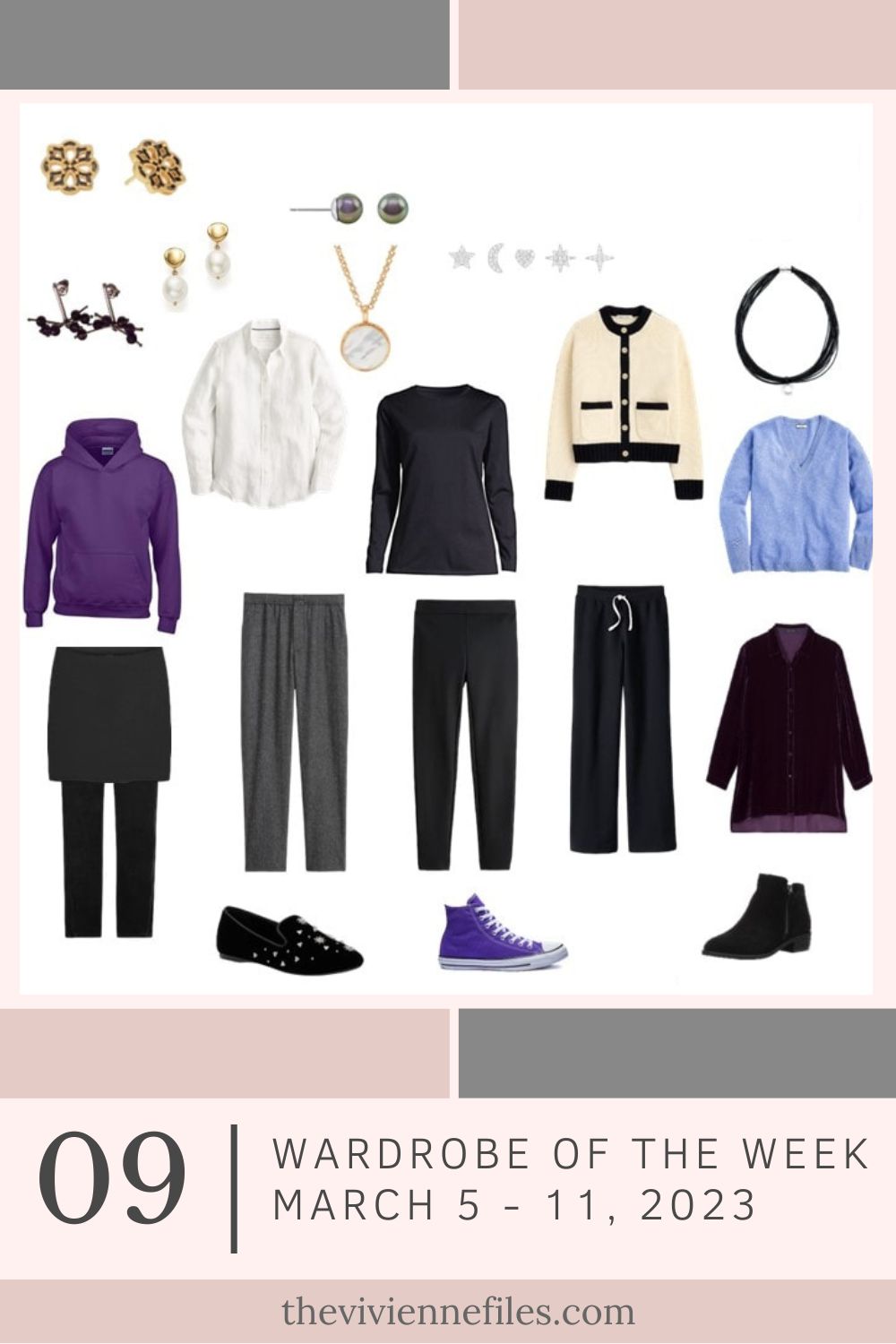March 12, 2023
We expected, but did not experience, TWO snowstorms this week…

black & gold earrings – Julie Vos; amethyst earrings – Art Institute of Chicago, pearl earrings – Bloomingdale’s; grey pearl earrings – Majorica; Mother of pearl pendant – Julie Vos; crystal earrings – APM Monaco; pearl & piano wire pendant – MFA Boston; purple sweatshirt – Colorful Standard; white shirt – 4 Objects; black wool tee shirt – Wool&; tipped cardigan – Alex Mill; blue sweater – J.Crew; skirted leggings – Eileen Fisher; tweed pants – Alex Mill; black pants – Eileen Fisher; sweatpants – Lands’ End; velvet tunic – Eileen Fisher; beaded flats – Birdie; purple high-tops – Converse; waterproof boots – Blondo
It’s a somewhat challenging technical slog, but sobering; they recommend 85 garments (including shoes) in a wardrobe for a 4-season climate.
More on this to come, I’m sure!
love,
Janice

Like this wardrobe? Save it to Pinterest!
Assuming accessories other than shoes are not included, I could just about do that. A combination of what I have learned from TVF and Project 333. But I think it would require mostly giving up the fun of different color palettes in spring and fall. Sobering, indeed.
Ditto what Ruth says. I have a count of 64 in my Style App, but that doesn’t include some of my sweatshirts/tshirts or sweats I wear around the house. Probably a dozen shoes – but some of them I barely wear. I’ll have to admit, after the Pantone exercise last week I can see where you would want the comfort and ease of black! I”m not sure why I found some of those colors just way too bright for me. Thanks again Janice for this look behind the scenes.
I think if I counted all the footwear in my cupboards, and this is after a retirement purge of dress shoes, I would have well over 50 pairs of walking shoes and hiking boots, dress shoes, sandals, flip flops, winter boots, wellies, trainers, gardening/old scruffy muck-about shoes…..and then there is the coat collection….! I guess I could do with 85 items total but I am not sure that every situation would be comfortably accommodated.
But why? Getting rid of whatever is over the 85 doesn’t help the environment in the slightest. I have owned some of my clothes for 30 years; a few pieces, well made by my grandmother, even longer. Having a lot of clothes means wearing individual pieces less, so they last longer. It also makes ‘shopping the closet’ easier. If you have limited space or are trying to downsize, then I suppose 85 could be a useful goal, but I suspect that for many people, closet-purging is like dieting: whatever you’re trying to get rid of just comes back.
I agree that the point is NOT to get rid of things! The most environmentally friendly wardrobe is the one that you already own… But the idea that someone has actually come up with a firm number recommendation, based on global climate goals, fascinates me…
hugs,
Janice
So nice to have this extra posts over the weekend! And even more bringing up advices to do our bit to help the environment. Being a professional on the sustainability field, I think this number is a dissemination tool (as the Ecological Footprint) to prevent over consumption and accumulation. Not to throw half of what you already own, but to highlight that what we actually need doesn’t match what we buy. The thing with fashion is that is gone so off the rails in neglecting the limits of the planet that it really needs to make drastic shifts. For example, France was the first country to ban in 2022 burning unselled clothes, a common practice in the retail world (!).
Janice, over the years you’ve been sharing some ways to better adapt to a changing environment. Cheers to that!
This is a good discussion to have.
Its more about changing the cycle of unsustainable clothing ( from manufacturing to wearing/discarding) to making sustainable fashion a real viable thing.
Here is the link to the 2022 report:
https://hotorcool.org/wp-content/uploads/2022/12/Hot_or_Cool_1_5_fashion_report_.pdf
Fast fashion is an human rights issue, as well as environmental rights.
I agree with Dame Eleanor that you might purge your closet one year but then your weight/shape changes in the next so you buy/replace clothes that actually fit. This happened to me after the pandemic. Having purged my wardrobe of too big clothes as a confidence boost after successful weight loss, I regained all the weight and have had to buy new clothes to replace the ones I’d got rid of and the clothes I had slimmed into are redundant. I couldn’t find replacements for a lot of my dresses and skirts because I’ve also found that my middle-aged shape is different to when I was younger. I’m having to buy different styles of garments that fit or disguise this which involves a style rethink. A lot of my close fitting tee shirts are now redundant. If I get rid of them, I would have to get rid of coordinating 2nd layers. Mind you if I’m not wearing them either, will I miss them? But I’m trying to slim…. 🤔 Life is full of choices.
In the last 3 years (Covid) I really haven’t bought hardly any clothes and have been quite happy. Interesting exercise – that’s when I had a go at adopting Weekly Timeless Wardobe which is worn based on temperature rather than seasons. Even some clothes in the wardrobe not worn.
Thanks for guidance.
A number of retailers in the UK are beginning to sell their unsold clothes through charity shop tie-ups. The preloved market in the UK is booming. No-one wants to buy clothes at full price, so retailers are forever offering discounts to online customers. This further erodes the need for high street shops. Clothes like food are a commodity. It is interesting that this report suggests 85 items for a four season wardrobe but do we still shop seasonally? Most of my clothes can now be worn for 6-9 months of the year.
I really appreciate how the blog leads me to think about my clothing choices on many levels. When I first discovered your site a few years ago, I used it as a tool to focus on my work wardrobe. Now that I’ve retired I’ve been able to purge wisely and use a reselling site that points out the impact on the environment when moving clothes on. I haven’t missed a single item! I love fashion and beautiful colors but I know I have to refrain from buying every pretty item. Your posts help to indulge that fantasy shopping while keeping me aware of what I truly need. Hmm, now I can ponder about what the environment needs too. I’m sure I have more than 85 pairs of socks, so still a work in progress.
Interesting.
I agree with Dame Eleanor that getting rid of items to reach 85 pieces doesn’t help the environment at all.
But perhaps the point is to make people realise that they don’t need as much as they think they do.
I often look to the past to understand today’s problems, and if we look back just a hundred years ago people (apart from the very wealthy) got by with just a few outfits. They had their fancy outfit which they could wear to every special occasion, and then two or three work/everyday outfits. This is, of course, a generalisation as it varies depending on time period, economic status, occupation, geographic location. But still, imagine having four outfits that cover ALL your needs! And that made of sturdy material that lasts, and designed to be easy to mend.
Beth T, I have gone through the same ups and downs and midlife shape changes as you. I learned a tip, probably during my “pregnant and nursing” years of having a “save for later” box to keep items that don’t fit now but I love and don’t want to get rid of. I have actually managed to lose some weight (it took a lot longer than I hoped) and got that box down. I was pleasantly surprised to find several items I can now wear that still look relevant and work in my current wardrobe even after several years (hurrah for classic stables!), and some I got rid of because my taste, shape and colors have changed. A few went back into the box with some more recent additions. I think this is a great way to deal with that ever-present struggle of weight change vs expense. Note: I have been actually getting rid of too-big clothes. Hopefully that will motivate me not to go back up!
Does that 85 include lingerie and socks? I’m hoping not as lingerie is my ‘buckyouupoh’
Nope. My understanding was garments and shoes… It’s an interesting thing to ponder, isn’t it?
hugs,
Janice